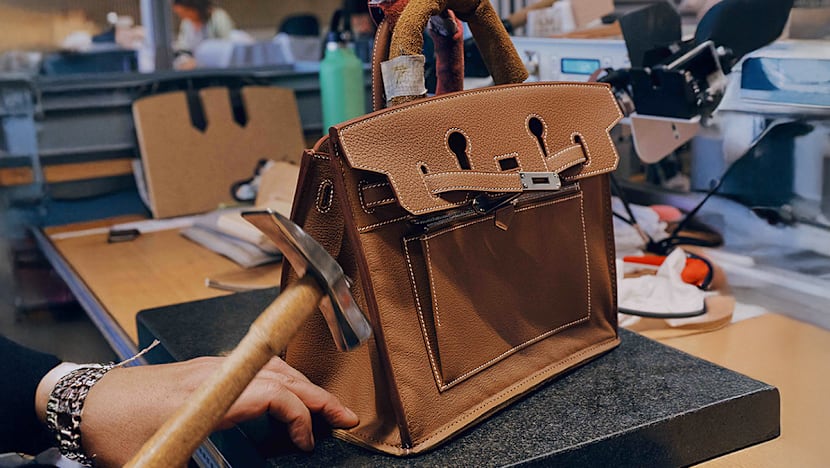Lifestyle
Hermes Expands Artisan Craftsmanship with New Leather Atelier

Hermes has inaugurated its latest leather workshop in L’Isle-d’Espagnac, a small town in southwestern France, marking a significant expansion of its artisan craftsmanship. Officially opened in late September 2025, this new atelier aims to employ around 300 people, including 260 artisans dedicated to producing the iconic Birkin bags and other luxury goods.
The Birkin bag, a symbol of luxury since its introduction in 1984, is crafted with an extraordinary attention to detail. Every bag begins its journey at the hands of artisans like Odile, who carefully shape the leather into its final form. “Every Birkin starts life inside out,” Odile explained through an interpreter, emphasizing the meticulous process that characterizes the brand’s commitment to craftsmanship. The workshop environment is marked by a soothing silence, where the sounds of fingers brushing leather and the gentle taps of hammers create an atmosphere of concentrated artistry.
This new workshop is the 24th leather-making facility for Hermes, reflecting the luxury house’s strategy to meet the increasing global demand for its products. In 2024, Hermes reported revenues of €15.2 billion, a notable 15 percent increase from the previous year. Despite this growth, the brand maintains a production philosophy that prioritizes quality over quantity. “We are fortunate enough to have incredible customers asking for our bags, and we can’t supply the demand,” said Olivier Fournier, Hermes’ executive vice president of corporate development and social affairs.
Commitment to Craftsmanship and Community
Hermes’ dedication to craftsmanship is deeply rooted in its history. Founded in 1837 by Thierry Hermes, the company originally specialized in harnesses and accessories for horse riding. The artisan techniques used today remain unchanged, with the same saddle stitch employed since the company’s inception. “The same saddle stitch used in 1837 is still used today,” Fournier noted, highlighting the enduring legacy of traditional craftsmanship.
The new atelier in L’Isle-d’Espagnac is not just a production facility; it embodies the company’s commitment to fostering community and providing dignified long-term employment. The workshop is designed to employ artisans who are trained over a period of 18 months, ensuring that every worker is well-versed in the brand’s rich heritage. Many artisans come from varied backgrounds, such as caregiving or teaching, and are selected not only for their dexterity but also for their ability to work collaboratively.
As part of its social responsibility, Hermes aims to create jobs in regions with a manufacturing tradition. Each new workshop generates approximately 300 jobs, contributing to local economic growth and stability. “We try to look for areas in France where there was a manufacturing tradition,” Fournier explained.
Luxury Defined by Time and Tradition
The allure of the Birkin bag is not merely its design but the scarcity that surrounds it. Earlier this year, the original Birkin, made for Jane Birkin, sold at auction for €8.6 million (approximately US$10.02 million), becoming the most expensive fashion accessory ever sold in Europe. Despite this demand, potential buyers often find themselves on lengthy waitlists, as Hermes refuses to compromise on the time-intensive production process that ensures each bag is crafted to perfection.
Fournier explained, “The way we produce our bags takes time. And we don’t want to force the pace.” This philosophy emphasizes that luxury is defined by the time taken to create each piece, rather than artificial scarcity. In a world increasingly focused on speed and efficiency, Hermes stands out by choosing to “multiply slowness.” The company opens one new workshop each year, carefully selecting and training artisans to preserve the integrity of their craft.
While Hermes operates additional production sites in countries like Switzerland, Italy, and the United States, the heart of its craftsmanship remains in France. The company has announced plans to establish three more leather workshops in regions such as Loupes near Bordeaux and Calvados in Normandy, reinforcing its commitment to local craftsmanship and community.
As the afternoon light filtered through the new workshop, Odile completed yet another Birkin, a testament to the enduring art of leatherwork. The careful inspection of seams and the gentle handling of materials reflect the dedication to quality that has defined Hermes for nearly two centuries. In a fast-paced world, the maison continues to prioritize time, skill, and authenticity, offering a narrative that resonates with consumers seeking more than just luxury products.
-

 Business5 months ago
Business5 months agoKenvue Dismisses CEO Thibaut Mongon as Strategic Review Advances
-

 Lifestyle5 months ago
Lifestyle5 months agoHumanism Camp Engages 250 Youths in Summer Fest 2025
-

 Sports5 months ago
Sports5 months agoDe Minaur Triumphs at Washington Open After Thrilling Comeback
-

 Sports5 months ago
Sports5 months agoTupou and Daugunu Join First Nations Squad for Lions Clash
-

 Top Stories5 months ago
Top Stories5 months agoColombian Senator Miguel Uribe Shows Signs of Recovery After Attack
-

 World3 months ago
World3 months agoSouth Korea’s Foreign Minister Cho Hyun to Visit China This Week
-

 World5 months ago
World5 months agoASEAN Gears Up for Historic Joint Meeting of Foreign and Economic Ministers
-

 Health5 months ago
Health5 months agoNew Study Challenges Assumptions About Aging and Inflammation
-

 Business5 months ago
Business5 months agoOil Prices Surge Following New EU Sanctions on Russia
-

 Entertainment5 months ago
Entertainment5 months agoDetaşe-Sabah Violin Ensemble Captivates at Gabala Music Festival
-

 Business3 months ago
Business3 months agoStarling Bank Plans Secondary Share Sale, Targeting $5.4 Billion Valuation
-

 Entertainment5 months ago
Entertainment5 months agoBaku Metro Extends Hours for Justin Timberlake Concert









